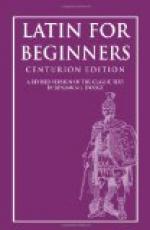344. The present subjunctive is inflected as follows:
CONJ. I CONJ.
II CONJ. III CONJ.
IV
ACTIVE VOICE
SINGULAR
1. a’mem mo’neam
re’gam ca’piam au’diam
2. a’me:s mo’nea:s
re’ga:s ca’pia:s au’dia:s
3. a’met mo’neat
re’gat ca’piat au’diat
PLURAL 1. ame:’mus monea:’mus rega:’mus capia:’mus audia:’mus 2. ame:’tis monea:’tis rega:’tis capia:’tis audia:’tis 3. a’ment mo’neant re’gant ca’piant au’diant
PASSIVE VOICE SINGULAR 1. a’mer mo’near re’gar ca’piar au’diar 2. ame:’ris monea:’ris rega:’ris capia:’ris audia:’ris (-re) (-re) (-re) (-re) (-re) 3. ame:’tur monea:’tur rega:’tur capia:’tur audia:’tur
PLURAL
1. ame:’mur monea:’mur rega:’mur capia:’mur audia:’mur
2. ame:’mini: monea:’mini: rega:’mini: capia:’mini: audia:’mini:
3. amen’tur monean’tur regan’tur capian’tur audian’tur
a. The present subjunctive is formed from the present stem.
b. The mood sign of the present subjunctive is -e:- in the first conjugation and -a:- in the others. It is shortened in the usual places (cf. Sec. 12), and takes the place of the final vowel of the stem in the first and third conjugations, but not in the second and fourth.
c. The personal endings are the same as in the indicative.
d. In a similar way
inflect the present subjunctive of curo\,
iubeo\, sumo\, iacio\,
munio\.
345. The present subjunctive of the irregular verb sum\ is inflected as follows:
{ 1. sim { 1. si:mus
SING. { 2. si:s PLURAL { 2. si:tis
{ 3. sit { 3. sint
346. The Indicative and Subjunctive Compared.
1. The two most important of the finite moods are the indicative and the subjunctive. The indicative deals with facts either real or assumed. If, then, we wish to assert something as a fact or to inquire after a fact, we use the indicative.
2. On the other hand, if we wish to express a desire or wish, a purpose, a possibility, an expectation, or some such notion, we must use the subjunctive. The following sentences illustrate the difference between the indicative and the subjunctive ideas.
INDICATIVE IDEAS SUBJUNCTIVE IDEAS




